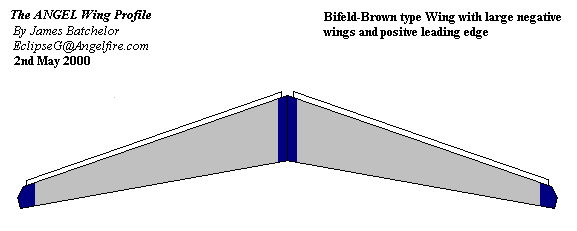
In essence, the wing utilises the Biefeld-Brown effect to fly, and this will be coupled with secondary Advanced Propulsion systems onboard ANGEL to create the final craft. In tests, the electrogravitic lift obtained from the craft was proportional to the size of the wings, and interestingly, THE MATERIAL THEY WERE MADE OF. This fulfills the criterion which Brown specified, saying that:

The heavy dielctric wing was suspended between two pylons so that it could sing freely in response to any movements generated. There is no exposed metal on the wing, except the front wire, a miniscule area. The wing shell is made of plastic. There was a wire sonnected through the shell of the wing onto the foil inside, and another one soldered to the leading wing wire.
A potential of 175 Kilovolts was applied (approximately 100uA current) with the wing body and the leading edge as negative.
What follows in terms of results is nothing short of a quantum leap for the project. The potential was applied and almost instantly the results were visible. Normally, there is a great deal of hissing due to ionisation from these type of devices, but here there was none.
Within 1/3 of a second of the power being activated, the wing array took a huge leap forward, straining hard on the wires. It is hard to estimate the precise amount of thrust, but it is much, MUCH greater than is typically encountered on any previous electrogravitic devices. Once the potential was removed, the wing moved gently back to the starting postion, indicating a very high capacitance in the device. The thrust exhibited by the device when the main body was positive was about 1/4 that which was encountered in the other configuration.
In recent days, I have virtually finished the physical structure of the ANGEL craft, and will shortly be getting to work on the electrics and avionics. I thought it would be beneficial here to display what the wing structure is in side profile. IMPORTANT NOTE: After consideration, I have decided that the testing of ANGEL will commence in a number of stages:
This work is ongoing, and I will endeavour to bring you new data as soon as I have it.